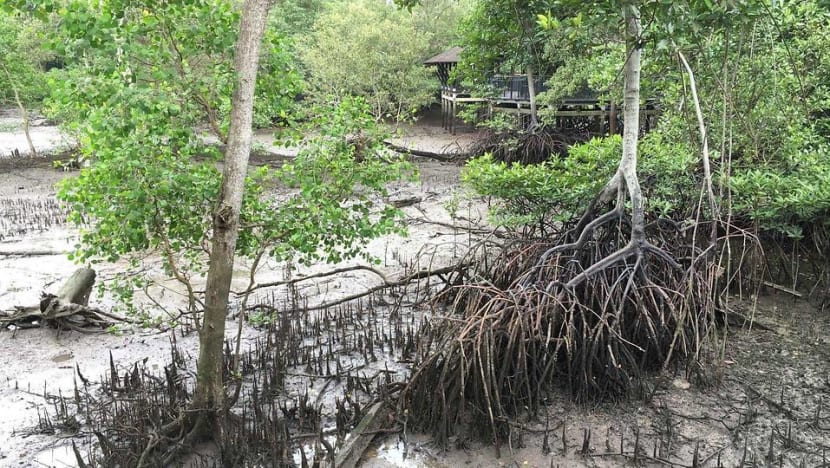How Singapore's mangroves can contribute in the battle against climate change

Mangroves at Sungei Buloh Wetland Reserve. (Photo: NParks Facebook)
SINGAPORE: Think of mangroves as a bank account, but instead of storing money, this account stores carbon and actively takes in carbon dioxide from the atmosphere.
And while Singapore’s mangroves make up a small part of its total land area - about one per cent - they have a role to play when it comes to carbon storage.
“What’s great about mangroves compared to other types of forests is that they store a lot more carbon (in the same amount of area),” Associate Professor Daniel Friess told CNA.
In regular forests, organic matter such as leaves and branches are broken down and carbon dioxide is released back into the atmosphere. But this happens much more slowly in mangroves as they are waterlogged, said National University of Singapore's (NUS) Dr Friess, who has studied mangroves in Singapore for over ten years.
“Mangroves are great because they can store three to five times more carbon per hectare than other forest types (typically) do,” he explained.
Based on data collected by Dr Friess and his colleagues in 2015, it was found that Singapore's mangroves contained 450,571 tonnes of carbon - the equivalent to 1.65 million tonnes of carbon dioxide.
When the study was published, this was roughly equivalent to the annual per capita emissions of about 620,000 people.
In addition, mangroves store about 11 per cent of the carbon in all of Singapore's forests, but cover less than six per cent of the forest area in Singapore.
“When people first started talking about using forests to store carbon and help against climate change … the focus was all on tropical forests and tundra and these other things. No one really thought about mangroves or seagrass,” said Dr Friess.
READ: IN FOCUS: How urbanised Singapore is learning to live with its wildlife
“In the last ... eight years or so, things really ramped up, because people started to realise how efficiently (they) were storing carbon … You get more bang for your buck in the same area that has more carbon (stored) in the mangrove.”
This phenomenon - dubbed blue carbon - has gained traction, in recent years. Blue carbon refers to carbon stored in coastal and marine ecosystems, including in sea grasses, tidal marshes and mangroves.
There has been a push to conserve and restore these ecosystems, as they serve a number of functions, including reducing the impact of climate change.
Plants that can store carbon help in the fight against climate change as carbon dioxide, a greenhouse gas, traps heat in the atmosphere and contributes to global warming.
Speaking to CNA, Earth Observatory Singapore (EOS) director Benjamin Horton noted how carbon capture and storage technologies can often be “incredibly expensive” and need to be “cutting edge”. In comparison, natural systems such as mangroves provide a simpler solution, he added.
But these systems alone, both in Singapore and globally, will not be enough to offset emissions, he noted, pointing out that there are other reasons connected to climate change which make mangroves worth preserving.
“If you look at the greenhouse gas concentrations, the vast majority of it is from industrial use, particularly the energy sector ... transportation, but then a significant proportion is land-use change (which) contributes 15 to 20 per cent in any one year,” he said.
“What we need to do is stop that land use change. So we need to stop deforestation in the Amazon, Africa, Southeast Asia, and we need to stop removing our mangrove and our salt marshes, because it's contributing to that. So, the idea of expanding them is interesting, but to me, the most important thing is to stop the deforestation.”
What is needed to tackle climate change is a “holistic approach” which incorporates different solutions, he said.
“You can't just say we're going to continue to burn fossil fuels … and then we'll offset by carbon capture and storage or natural solution to climate change. It has to be part of the solution.”
Singapore Nature Society president Shawn Lum noted that Singapore is a bit of a "special case" being a city-state.
"The reality is that if we're still burning fossil fuels at a high level - and it seems like we're committed to reducing that - but with five, six million people, energy intensive lifestyles and industry, that's a lot of carbon emissions per capita. The reality is we just don't have the forests, the mangroves, the reefs ... to capture all of that carbon."
However, this is not to say coastal ecosystems like mangroves are not important, he added.
"Having the presence of these nature-based solutions all around us to remind us of the importance of nature as part of our mitigation and defence against climate change and sea level rise could trigger something in all of us to make us think ... (and) start to build in carbon accounting or climate offset into either business models of companies or lifestyles that we adopt - I think it can make a huge difference," Dr Lum explained.
AN ‘UNDERVALUED’ ASSET
Over the past 50 years, Singapore has lost large swathes of mangroves.
In 1953, it was estimated it had 63.4 sq km of mangroves. In 2018, the country’s mangrove area was estimated to be 8.1 sq km, said Prof Friess. And there is a need to conserve and protect what is left, he pointed out.
“Before planting new mangroves, the first thing is to conserve what we already have,” said Prof Friess. “Once you've done that, then then you can think about the restoration and planting more mangroves.”
READ: Singapore ‘pushing the boundaries’ on mitigating climate change: Masagos
Singapore’s mangroves grow in “very specific environments”, noted Associate Professor Adam Switzer, who is also from Nanyang Technological University’s (NTU) EOS.
“There's a fairly narrow range of environments the mangrove can thrive on, and that means you need a reasonably sheltered area, and you need a certain tidal prism, it needs to be away from currents and waves, and you need a certain muddy substrate for the mangrove to take hold, and that could take several decades to start to build what would look like a reasonable size mangrove system,” he said.
“So, the ones that we have now, we do need to conserve them because there's such a narrow band of opportunity in terms of areas of the coast that can support mangroves.”
In a speech last year, then Minister for the Environment and Water Resources Masagos Zulkifli had said that Singapore’s plans to tackle climate change will incorporate nature-based solutions involving mangroves.
“To boost our natural defences such as mangroves, we take both hard and soft engineering approaches to mitigate coastal erosion and actively restore our mangrove areas,” he said.
The combination of hard engineering approaches with soft engineering approaches such as the plantation of mangroves would be a “fantastic” one, noted Dr Switzer.
He said: “It’s about getting all the different possible solutions on the table … If you want to defend a part of the Singapore coastline, can we build something that is a combination of both hard and soft engineering, that provides the best of both worlds - it protects us from sea level rise, or tidal currents or waves, but it also allows formation and growth of the mangrove ecosystem to very important, both to the local area and country and the region?”
LISTEN: When it comes to climate change, why is CO2 public enemy number one?
Dr Horton, who is a climate scientist, pointed out these ecosystems also
protect our coastline from storm surges and erosion. He gave the example of coastlines that had “extensive, full" mangroves resulting in inland areas being protected significantly from the 2004 Indian Ocean tsunami.
Singapore's mangroves systems can serve other purposes, said Dr Horton and Dr Friess.
“They can be a testbed for understanding how you can have the greatest carbon storage ... how in an urban setting do you allow mangroves to thrive. That's the key,” he said. “Coastal ecosystems, be they marshes or wetlands in temperate regions (or) mangroves in tropical regions have been much undervalued,” said Dr Horton.
There are also "cultural benefits" which mangroves provide, added Dr Friess.
“So many people at the weekends are at Ubin, they are at Sungei Buloh, at Pasir Ris park, at Labrador Park," he pointed out. "People are enjoying mangroves and it's a way of connecting with nature. And I think we're all really aware of this after the 'circuit breaker'."
READ: Sungei Buloh Nature Park Network to be established, includes new Lim Chu Kang Nature Park
And mangroves are “working hard” in the background without many noticing them, pointed out Prof Friess.
He said: “They're supporting our species and they're supporting our fisheries … and they're doing it all very quietly in the background, not making a fuss - so they are kind of these unsung heroes.”














